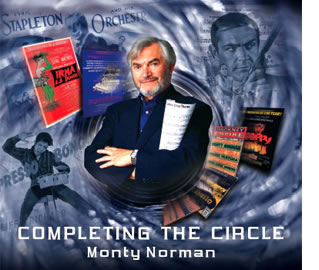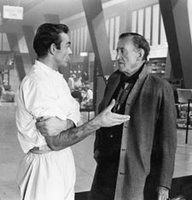



AKA Monte Norman
 |
 |
 |
 |
||
| Monty Norman AKA Monte Norman | John Barry | Provided as a hint | The author, the star and the scenery |
G8 Kicker. Originally track 27, modified to track 28 in version 8.3, to track 29 in version 8.4
Assuming that you have Windows Media Player on your system, you should be listening to possibly the greatest movie theme ever created, at least from the point of view of longevity. It has had some controversy over the years since it was introduced in 1962. Technically, and by rule of a verdict in a lawsuit some 30 years after it originated, this theme is the work of Monty Norman. Norman, from England, who was born of Latvian emigre parents in London on the night of the second seder in 1928 (with this background, could one claim this music as part of the beginnings of Israeli dance), was both a singer and composer. Even more importantly, in 1962, he was a friend and associate of one of the principals of an embryonic partnership to bring a series of movie adaptations of best sellers to the screen.
The first movie was to take place in Jamaica and Norman was sent there to provide background music. Eventually, he was asked to create a theme song that could be used with both the beginning and ending titles. In creating this theme, he says he thought back to one unremarkable song that he had written years earlier, long forgotten by almost everybody, whose beginning notes could be sliced into the beginning notes to what you may be listening. He thought these beginning notes would capture the mood of both the fictional character and of the movie that was at that point in production. Obviously, he was right.
Coincident with this, the producers had brought in John Barry Penderghast (the son of a family that owned a chain of movie theaters and who went by the name of John Barry professionally) the band leader of the John Barry Seven, a modern jazz ensemble, to further compose and enhance the movie background music that Norman had created. Barry was also given a crack at this theme after Norman had created the original template. In Barry's case, he had done the music to the L-Shaped Room, a low budget movie released in 1960 and to Walk, Don't Run. He used several chords (or whatever in music terms)from the first and quite a bit of the second to add melody to Norman's theme.
In the end, we have to thank Vic Flick, the Barry Seven lead guitarist brought in to actually play the music for the movie, for his effect on this theme song. His interpretation of the beginning notes is what has been emulated through 21 additional movies and countless takeoffs making this music one of the most recognized (and hummable) melodies in the world.
Norman was given credit for this music in the movie and the subsequent sequels but, in 1992, he sued Barry for several quotes that Barry had given in interviews claiming credit for its creation. A London jury and spectators were treated to many interpretation and renditions of this theme during the subsequent court case. It was the jury's decision that Norman was the creator of this now ubiquital theme.